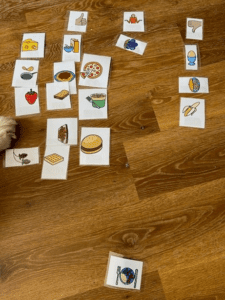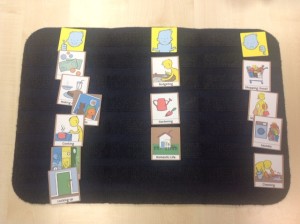Question: What is a Talking Mat?
Answer: Talking Mats is a visual communication framework which supports people with communication difficulties to express their feelings and views.
That’s what our website says in black and white and you wouldn’t be alone in thinking it actively excludes people with a visual impairment. However, one of our Licenced Trainers and Speech and Language Therapist, Olivia Ince recently got in touch to share a story of a creative and innovative approach to using the tool; a Braille Talking Mat.
The mat was facilitated by an Outreach worker for Children with disabilities (the listener) who had been trained in Talking Mats by Olivia. The young person sharing their opinions (the thinker) has a genetic neurodegenerative disease which affects the nervous system, causing progressive difficulties with physical and cognitive skills including communication impairment and vision loss. The Outreach worker and Olivia worked on the project together.
Trialling a Braille Talking Mat
We have been working together on a project to trial a Braille version of a Talking Mat. Talking Mats is a visual tool, but we knew that a Braille version could work in theory if some adaptations were made and if the thinker had the cognitive ability to understand the Talking Mats process.
We thought a Talking Mat would be a good approach for this young person because it could help to make the conversation more engaging and create a more balanced interaction than asking a long list of questions. For this young person, the Talking Mat was primarily a thinking tool.

Introduction:
We started the process by introducing a concrete, familiar topic; food with the topscale of ‘like/ don’t know / don’t like. Using a concrete topic like food meant that the listener could discuss the responses with the young person’s wider network and find out if the mat was a true reflection of food preferences, thus giving further insight into the young person’s understanding of the Talking Mats process.
Adaptations:
The support team had access to a Braille machine which meant that a Braille sticker could be added to each laminated symbol card in the Talking Mat. Having both Braille and symbols on the cards meant that the Talking Mat was meaningful to the thinker and the thinker’s network, as a photo could still be taken as a record and to allow any actions to be followed up.
As usual, the listener handed the card to the thinker which allowed them to read the Braille.
- After reading each option card, the thinker then passed the card back to the listener and told the listener where to place each one under the top scale.
- At the end, the listener asked the thinker if they would like to read the Braille on all the cards again as part of the review and reflect. The thinker did not wish to do this, so the listener verbally reviewed the Talking Mat for the thinker.
We considered the alternative approach of guiding the thinker’s hand across the top scale allowing them to read the Braille after having read the Braille on each option card. The thinker could then have placed each option card under the top scale with some hand over hand guidance, but this was decided against due to the increased physicality and cognitive load of this additional action for the thinker.
Reflections:
When the Talking Mat was initially discussed the young person expressed curiosity about what it was and how it worked. Throughout the session they appeared to feel involved, enjoying the tactile and interactive nature of the Talking Mat process, increasing engagement with the process.
The Talking Mat helped the thinker to share their views on a wider variety and greater number of options than what would have been possible in a verbal conversation on the same topic. The Talking Mat also facilitated a more structured, empowering and accessible interaction for the thinker and created the time and space for them to share their views.
Now that this trial Braille Talking Mat has demonstrated that the thinker can engage in the Talking Mat process from start to finish and that they seemed to enjoy sharing their views using this tool, in future further Talking Mats could be used to help the thinker share their views on more abstract, emotive topics.
Overall, this project has shown that a Braille version of a Talking Mat can successfully support people who have a visual impairment to share their views.
If you would like to find out more please contact us on info@talkingmats.com and questions can be passed onto Olivia.
We are frequently asked if Talking Mats can be used by someone who is blind and we usually say ‘not really as its essentially a visual tool’. However today I had to eat my words when I was interviewed by Ian Hamilton who is a BBC Scotland TV and radio reporter. Ian is totally blind and was accompanied by his guide dog – a very large but gentle German Shepherd called Renton. Here is a link about Ian and Renton
When Ian asked me to explain Talking Mats I guided his hand to the positioning of the 3 top scale symbols and then he immediately understood the layout of the top scale, the topic at the bottom of the mat, and where to place each option by touch. I simply explained each symbol, placed it in his hand and he did the rest. The topic was how Ian feels about Domestic Life and we had a lot of laughs about his dislike of shopping, laundry and cleaning. He explained that shopping was a nightmare for someone who is blind. He said that the dislike of laundry and cleaning showed that he was lazy – I think it’s pretty much what lots of people think!
However he was clear about a number of things that he feels very positive about, in particular his daily routine and his security, both of which are very important because of his blindness. Interestingly he said that his guide dog is clearly on the positive side of the mat, but not as a pet. A dog like Renton is not just a form of mobility, he’s also a fantastic companion.
Ian seemed to keep 1 step ahead of me and asked loads of great questions about Talking Mats as a thinking tool and its possibilities for other groups of people. He commented that, like inventions such as the typewriter and the phone, Talking mats is something originally intended for people with a disability, but which is now being used by people of all abilities to help them consider issues and then express their views.
Ian generously agreed to me writing this blog and using his photo.

The programme will be broadcast on BBC Radio Scotland : Business Scotland on 24th and 25th May
 Online training login
Online training login 



